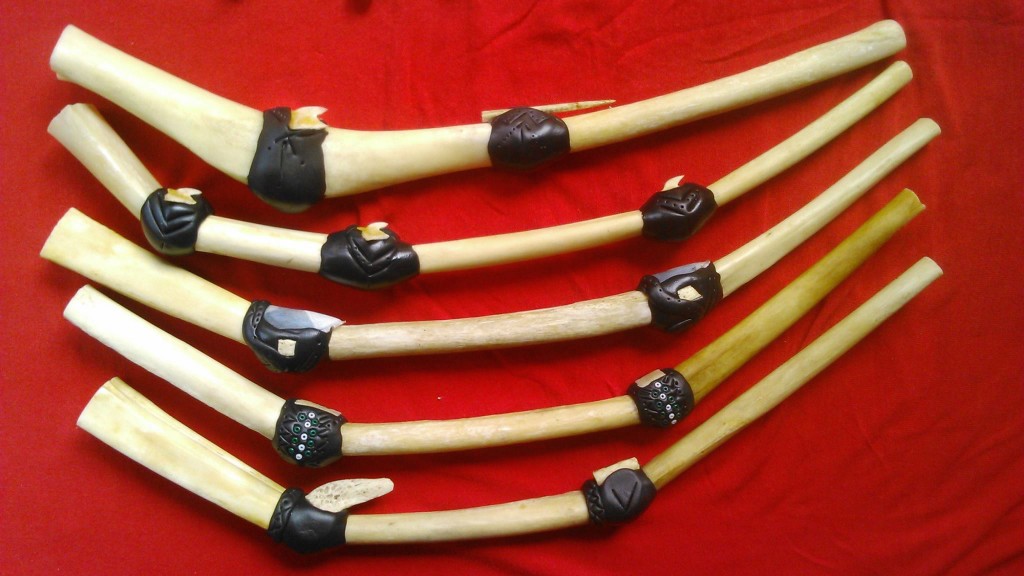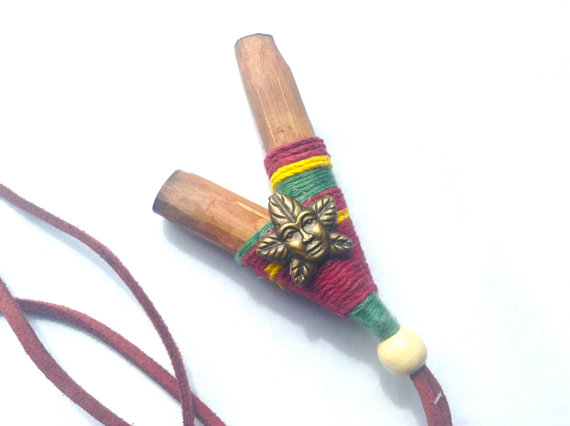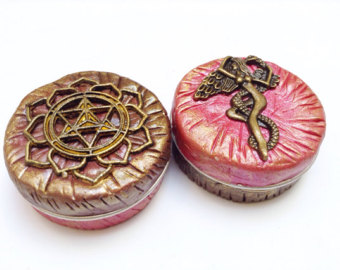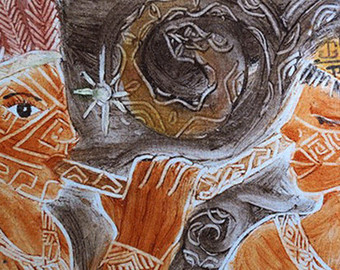
Rapé
Rapé (pronounced ha-PAY) is a preparation of powdered medicinal herbs – often with a tobacco base – that the Indians of the Amazon basin blow through the nose, either with a small V-shaped self applicator, or with the help of a buddy.
In contemporary Amazonia, sharing rapé is a common social activity with spiritual, pre-Columbian roots. Rapé is considered to be a sacred, shamanic medicine. It’s traditionally prepared by a knowledgeable shaman, however, the art of sacred rapé preparation has been passed on to non-indigenous rapé enthusiasts, so you can find makers of high-quality rapé outside tribal communities and in other parts of Brazil. Sharing rapé was traditionally done in a ritualistic way. Because the medicine can have stimulating or psychoactive effects (depending on what plants were used to make it) receiving rapé can bring about a profound experience of the Forest. Because the medicine is sacred, the Indians take rapé as a prayer calling upon the forces of Nature, the blessing of the animals of the forest, and power of medicinal plants to heal us and give us strength.

Nowadays, medicinal rapé is also making its way all over the world, through increasing cross cultural friendships between the Indians and non-indigenous friends, as well as through ayahuasca ceremonies held by traveling shamans. Rapé is increasingly being consumed in a more social context, in the way that sharing sacred tobacco shifted to social cigarette smoking.
Rapé is administered with two different types of pipes, which are typically made from bamboo or bone. The first type of pipe requires the assistance of another person, who blows the snuff with a powerful blast into each nostril of the partner who is receiving the rapé. For that reason it is generally referred to as the blow pipe and, in Brazil, the 2-person pipe is called the “Tepi”.
Rapé is administered with two different types of pipes, which are typically made from bamboo or bone. The first type of pipe requires the assistance of another person, who blows the snuff with a powerful blast into each nostril of the partner who is receiving the rapé. For that reason it is generally referred to as the blow pipe and, in Brazil, the 2-person pipe is called the “Tepi”.

If you don’t have a buddy to blow medicine up your nose, don’t worry, you can do it yourself with a self-applicator pipe called a “Kuripe”. A Kuripe is a small V-shaped pipe that connects your mouth to your nostril. While it’s always harder to blow yourself than to have a friend blow you, trying to get a noob to blow you (who has no idea how to do it) is the least desirable option. Thus it’s always good to have your own Kuripe, and learn how to blow yourself, if you are a bona fide rapé enthusiast.

What you don’t want to do is snort rapé off a smooth flat surface with a rolled up bill or straw. That is a major Amazonian faux pas – it won’t score you points with the Indians and might get you arrested by unamused Policia Federal for public cocaine consumption.

Because the act of taking rapé is a prayer, the set and setting will impact the experience of your prayer. The best places to take rapé are outside in nature, at the altar during an ayahuasca ceremony, or in a quiet sacred space indoors, with high-vibrational music playing. Avoid taking rapé while waiting at bus stops, in busy commercial areas, in common areas with a lot of movement that is unrelated to spiritual activity, or where you might be interrupted by someone who has no idea what you are doing nor what it means. An ideal setting allows you to fully experience the effect of the rapé without distraction and have the space for quiet contemplation.
Also, depending on the medicinal plants that were used in the rapé blend, you may experience a wide range of sensations after taking your rapé, from emotional upwellings, to vomiting and bowel movements. Here are some tips to set up your space – and yourself – for comfort:
It’s a good idea to have a bottle of water nearby and tissues or a roll of toilet paper for blowing your nose.
If you think you are going to be thirsty, drink water BEFORE snuffing your rapé, because any water you drink afterwards will task like rapé.
Don’t eat immediately before taking rapé, because it may come right out after
Make sure you have an easy place to vomit in case the urge suddenly descends upon you
Make sure you are also close to the toilet in case the opposite should occur
Make sure your friends are aware of what you are doing (so nobody interrupts your moment of deep contemplation at the moment your nose starts to run profusely) by asking you the best way to get on the I-80
What to Expect From Your Rapé Experience
Your rapé experience will depend a lot on the medicinal rapé blend you are consuming. There are a myriad of medicinal plants that can be used in rapé and thus a wide range of experiences from a nice blast of fragrance in your nose, to an eye-opening nasal expresso shot, to a transcendental, wildly psychoactive experience lasting hours, where you want to fly like an eagle.
There are a few common side effects to taking rapé that you should be prepared for and certainly not ashamed of:
Your nose will start running, and your sinuses will want to clear themselves out. . Lean forward – try not to tilt your head back, or your rapé filled mucus will start backdripping down your sinuses, which may cause you to gag, and then vomit. Hocking loogies during a rapé session is totally socially acceptable.
You may want to projectile vomit. It’s OK. Rapé is purifying and you are getting well. Try to vomit in the bushes.
You may want to take a giant dump. Bowel movements are good for you. If you have trouble staying regular, take rapé in the morning. It’s better than coffee.
Rapé Safety Tips for the Modern Shaman
As with any kind of potent medicine, rapé can be abused and consumed in ways that are less sacred, and more recreational. Rapé can be hard on your sinuses, so overuse can create sinus problems and damage to your respiratory system. Also, because the medicinal plants in rapé blends vary, its effects on your system can vary. Misuse can lead to addiction or even send you to the hospital. For this reason, it’s important to test your rapé and with any drug, know where it comes from. Also, using rapé with other drugs, like MDMA, is not advised as the contraindications may be unknown. Rapé is frequently offered during ayahuasca ceremonies, but you may want to tune in and decide whether rapé is really what your body needs at that moment.
Also, depending on the medicinal plants that were used in the rapé blend, you may experience a wide range of sensations after taking your rapé, from emotional upwellings, to vomiting and bowel movements. Here are some tips to set up your space – and yourself – for comfort:
It’s a good idea to have a bottle of water nearby and tissues or a roll of toilet paper for blowing your nose.
If you think you are going to be thirsty, drink water BEFORE snuffing your rapé, because any water you drink afterwards will task like rapé.
Don’t eat immediately before taking rapé, because it may come right out after
Make sure you have an easy place to vomit in case the urge suddenly descends upon you
Make sure you are also close to the toilet in case the opposite should occur
Make sure your friends are aware of what you are doing (so nobody interrupts your moment of deep contemplation at the moment your nose starts to run profusely) by asking you the best way to get on the I-80
What to Expect From Your Rapé Experience
Your rapé experience will depend a lot on the medicinal rapé blend you are consuming. There are a myriad of medicinal plants that can be used in rapé and thus a wide range of experiences from a nice blast of fragrance in your nose, to an eye-opening nasal expresso shot, to a transcendental, wildly psychoactive experience lasting hours, where you want to fly like an eagle.
There are a few common side effects to taking rapé that you should be prepared for and certainly not ashamed of:
Your nose will start running, and your sinuses will want to clear themselves out. . Lean forward – try not to tilt your head back, or your rapé filled mucus will start backdripping down your sinuses, which may cause you to gag, and then vomit. Hocking loogies during a rapé session is totally socially acceptable.
You may want to projectile vomit. It’s OK. Rapé is purifying and you are getting well. Try to vomit in the bushes.
You may want to take a giant dump. Bowel movements are good for you. If you have trouble staying regular, take rapé in the morning. It’s better than coffee.
Rapé Safety Tips for the Modern Shaman
As with any kind of potent medicine, rapé can be abused and consumed in ways that are less sacred, and more recreational. Rapé can be hard on your sinuses, so overuse can create sinus problems and damage to your respiratory system. Also, because the medicinal plants in rapé blends vary, its effects on your system can vary. Misuse can lead to addiction or even send you to the hospital. For this reason, it’s important to test your rapé and with any drug, know where it comes from. Also, using rapé with other drugs, like MDMA, is not advised as the contraindications may be unknown. Rapé is frequently offered during ayahuasca ceremonies, but you may want to tune in and decide whether rapé is really what your body needs at that moment.

As medicinal rapé appreciation grows around the world, rapé kits are increasingly part of the modern shamanic toolkit, and global shamans are finding themselves traveling with rapé and storing their medicine for longer periods of time due to the difficulty of procuring fresh rapé outside the Amazon. Here are some tips on how to care for your rapé and rapé applicators.
Care for your rapé applicator is going to depend very much on what materials were used to make it (bamboo, bone), hold it together (beeswax, durapox), and adorn it (string, feathers, stones, paint). Rapé applicators are sacred shamanic tools and typically kept at home on an altar or carried around in a medicine bag. You may want to keep your feather adorned tepi at home and have a simpler tepi for travel, because it’s really a bummer to discover that your beautiful tepi macaw feathers got crushed and broken in your backpack. Kuripe self applicators tend to travel better.
Care for your rapé applicator is going to depend very much on what materials were used to make it (bamboo, bone), hold it together (beeswax, durapox), and adorn it (string, feathers, stones, paint). Rapé applicators are sacred shamanic tools and typically kept at home on an altar or carried around in a medicine bag. You may want to keep your feather adorned tepi at home and have a simpler tepi for travel, because it’s really a bummer to discover that your beautiful tepi macaw feathers got crushed and broken in your backpack. Kuripe self applicators tend to travel better.

In the Amazon, sharing rapé has become a common social activity. In indigenous culture, everything is shared, so the Indians don’t tend to place as much importance on keeping personal use items, well, personal. If you come from an individualistic society, like the United States, your rugged individualism and hangups about your personal stuff is going to stand out. Also, Indians tend to have a strong belief that using a shared object to consume medicine isn’t going to get them sick, because the medicine is sacred, powerful, and will prevent that – magically. That being said, what do you do in a situation where you have 5 people wanting to pass your tepi pipe around, and one of them visibly has a cold or flu?
Using a Q-Tip, periodically clean your rapé applicator with alcohol or hydrogen peroxide Depending on what materials were used to construct your rapé applicator, the drawback to this is that the chemicals can cause bamboo to crack or adhesives holding the 2 bamboo tubes into a V to dissolve.
Use a lighter flame to disinfect the ends of your rapé applicator. Again, depending on what materials were used to construct your rapé applicator, the flame can cause the ends to blacken, and look unsightly.
The Amazon is a humid place. Using soap and water to clean your rapé applicator can be tricky as moisture can build up deep inside your applicator and grow mold, which is the last thing you want to be inhaling into your nose.
In the old days, rapé was stored in hollowed out gourds or giant snail shells. Nowadays, rapé made in the Amazon is typically stored in used soda bottles. Old plastic may not be the best container for long term storage of medicinal snuff. A preferred container by non-indigenous Brazilians are glass test tubes with screw tops. Not only are these easy to carry around, pouring rapé into the palm of your hand is also easier, because the shape of the container minimizes the avalanche effect that bottles with narrow necks can have.
With container with a narrow opening, you increase the likelihood of not being able to get all your rapé out, or know what’s going on at the very bottom if the container isn’t clear.
Glass test tubes are a great way to store and carry rapé.
Glass test tubes are a great way to store and carry rapé.
Rapé needs to be stored in a cool dry place. Moldy rapé will tend to have a distinct, acrid smell to it. If you find that your rapé is starting to go, you can spread it out in cloth or smooth clean surface and dry it out in the sun.
Do bear in mind that medicinal rapé has a shelf life and loses its effectiveness over time, so holding onto it for as long as it will last is not the best idea.
Use it or lose it.
Using a Q-Tip, periodically clean your rapé applicator with alcohol or hydrogen peroxide Depending on what materials were used to construct your rapé applicator, the drawback to this is that the chemicals can cause bamboo to crack or adhesives holding the 2 bamboo tubes into a V to dissolve.
Use a lighter flame to disinfect the ends of your rapé applicator. Again, depending on what materials were used to construct your rapé applicator, the flame can cause the ends to blacken, and look unsightly.
The Amazon is a humid place. Using soap and water to clean your rapé applicator can be tricky as moisture can build up deep inside your applicator and grow mold, which is the last thing you want to be inhaling into your nose.
In the old days, rapé was stored in hollowed out gourds or giant snail shells. Nowadays, rapé made in the Amazon is typically stored in used soda bottles. Old plastic may not be the best container for long term storage of medicinal snuff. A preferred container by non-indigenous Brazilians are glass test tubes with screw tops. Not only are these easy to carry around, pouring rapé into the palm of your hand is also easier, because the shape of the container minimizes the avalanche effect that bottles with narrow necks can have.
With container with a narrow opening, you increase the likelihood of not being able to get all your rapé out, or know what’s going on at the very bottom if the container isn’t clear.
Glass test tubes are a great way to store and carry rapé.
Glass test tubes are a great way to store and carry rapé.
Rapé needs to be stored in a cool dry place. Moldy rapé will tend to have a distinct, acrid smell to it. If you find that your rapé is starting to go, you can spread it out in cloth or smooth clean surface and dry it out in the sun.
Do bear in mind that medicinal rapé has a shelf life and loses its effectiveness over time, so holding onto it for as long as it will last is not the best idea.
Use it or lose it.

Buddy-Assisted Rapé – Step-by-Step
Blowing the Tepi involves an intimate connection between the rapé giver and receiver. Both are closely connected by mouth, nose and breath, and both need to open and allow the other spirit’s and intention to enter, allowing the healing to take place. The person blowing needs to be an experienced tribe member – like a shaman, or your medicine brother or sister – as the blower sends their intention and spirit to the person inhaling. That takes a strong mind and clear focus. Hence, the essence of this blowing ritual does not depend on the strength of your blowing, but whether you can share yourself while doing it and thereby empowering the receiver. These ‘blowing rituals’ are of great importance in the shamanic tradition, which perceives the healing energy of breath (Soplada) as a major tool for healing.
Lorna-Taking-Rape
Visitors to the indigenous territories of the Brazilian Amazon will be invited to share rapé with the tribe.
How Much Rapé Should You Serve?
Appropriate dosage really depends on the kind of rapé that is being taken and the individual on the receiving end. In Brazil, the Indians are used to taking copious amounts of rapé in one session. I’m often astounded at the amount of rapé that gets shoveled into the end of a tepi – and the recipient’s ability to take it, without throwing up or passing out. Because rapé is more difficult to procure outside of Brazil, North American shamans tend to use smaller quantities of rapé.
For buddy-administered rapé – it’s important for the person serving the rapé to make an intuitive and ethical assessment on the appropriate amount of rapé to offer the recipient of your soplada. Where are they from? What is their experience? How strong is your rapé?
Too much rapé can make your companion projectile vomit – which may be a good thing from the point of view of purification – but not at all what the other was wanting.
Err on the cautious side, you can always have another round.
Overdosing is less of an issue with self-administered rapé.
Blowing the Tepi involves an intimate connection between the rapé giver and receiver. Both are closely connected by mouth, nose and breath, and both need to open and allow the other spirit’s and intention to enter, allowing the healing to take place. The person blowing needs to be an experienced tribe member – like a shaman, or your medicine brother or sister – as the blower sends their intention and spirit to the person inhaling. That takes a strong mind and clear focus. Hence, the essence of this blowing ritual does not depend on the strength of your blowing, but whether you can share yourself while doing it and thereby empowering the receiver. These ‘blowing rituals’ are of great importance in the shamanic tradition, which perceives the healing energy of breath (Soplada) as a major tool for healing.
Lorna-Taking-Rape
Visitors to the indigenous territories of the Brazilian Amazon will be invited to share rapé with the tribe.
How Much Rapé Should You Serve?
Appropriate dosage really depends on the kind of rapé that is being taken and the individual on the receiving end. In Brazil, the Indians are used to taking copious amounts of rapé in one session. I’m often astounded at the amount of rapé that gets shoveled into the end of a tepi – and the recipient’s ability to take it, without throwing up or passing out. Because rapé is more difficult to procure outside of Brazil, North American shamans tend to use smaller quantities of rapé.
For buddy-administered rapé – it’s important for the person serving the rapé to make an intuitive and ethical assessment on the appropriate amount of rapé to offer the recipient of your soplada. Where are they from? What is their experience? How strong is your rapé?
Too much rapé can make your companion projectile vomit – which may be a good thing from the point of view of purification – but not at all what the other was wanting.
Err on the cautious side, you can always have another round.
Overdosing is less of an issue with self-administered rapé.

Guidelines for the Soplada Blower
Step 1: Find a quiet location where you can sit face to face. Ground down into the present moment.
Step 2: Look at the rapé recipient in the eyes and connect with that person.
Step 3: Give your recipient an orientation of what to expect, instructions on how to receive the rapé, and invite them to set an intention for the ritual.
Step 4: Ask how much rapé they would like to receive and how hard of a soplada they wish to have. If the recipient isn’t sure, follow the guidelines below on how to assess the appropriate amount of rapé to serve.
Step 5: Begin your rapé chant or prayer, connect with the spirit of the Forest, the spirits of the healing plants and ask them to bless the recipient.
Step 6: Staying grounded in the present moment, load half the amount of rapé from your palm into the far end of your Tepi. Then position the end of the Tepi snug against the opening of the recipients nostril so no rapé gets blown into the person’s eye.
Step 7:Mindfully blow the rapé into one nostril. Stay present with the recipient and tune into where the person is at with their experience.
Step 8: Check in with the recipient. Did they want a softer soplada? Harder? More rapé? Less rapé? Load the remainder of the rapé into the far end of your Tepi, then position the top snug against the opening of the opposite nostril.
Step 9:Mindfully blow the rapé into the other nostril. Stay present with the recipient and tune into where the person is at with their experience.
Step 10: After the second soplada, you may want to energetically assist in the removal of any blockages. With your fingers you may trace the movement of the rapé along the bridge of the nose up towards the crown of the head, as well as along the recipient’s temples. You may want to brush with downward strokes along the sides of their heads, and snap your fingers to dispel any negative energy.
Step 11: Close the session with a prayer, Haux, or Aho.
Step 1: Find a quiet location where you can sit face to face. Ground down into the present moment.
Step 2: Look at the rapé recipient in the eyes and connect with that person.
Step 3: Give your recipient an orientation of what to expect, instructions on how to receive the rapé, and invite them to set an intention for the ritual.
Step 4: Ask how much rapé they would like to receive and how hard of a soplada they wish to have. If the recipient isn’t sure, follow the guidelines below on how to assess the appropriate amount of rapé to serve.
Step 5: Begin your rapé chant or prayer, connect with the spirit of the Forest, the spirits of the healing plants and ask them to bless the recipient.
Step 6: Staying grounded in the present moment, load half the amount of rapé from your palm into the far end of your Tepi. Then position the end of the Tepi snug against the opening of the recipients nostril so no rapé gets blown into the person’s eye.
Step 7:Mindfully blow the rapé into one nostril. Stay present with the recipient and tune into where the person is at with their experience.
Step 8: Check in with the recipient. Did they want a softer soplada? Harder? More rapé? Less rapé? Load the remainder of the rapé into the far end of your Tepi, then position the top snug against the opening of the opposite nostril.
Step 9:Mindfully blow the rapé into the other nostril. Stay present with the recipient and tune into where the person is at with their experience.
Step 10: After the second soplada, you may want to energetically assist in the removal of any blockages. With your fingers you may trace the movement of the rapé along the bridge of the nose up towards the crown of the head, as well as along the recipient’s temples. You may want to brush with downward strokes along the sides of their heads, and snap your fingers to dispel any negative energy.
Step 11: Close the session with a prayer, Haux, or Aho.
Guidelines for the Rapé Recipient
Step 1: Find a quiet location where you can sit face to face. Ground down into the present moment.
Step 2: Look in the eyes of the person who will give you a soplada and connect with that person.
Step 3: Check in with yourself on the amount of rapé you would like to receive, eyeball what feels like the amount you need when the soplada blower pours the medicine into their palm, and let the person know.
Step 4: Focus on the intention of this ritual. What insight are you seeking? What prayer do you have that you want the spirits of Nature to hear?
Step 5: As the soplada blower begins their blessing, tune into Nature and your Spirit Guides.
Step 6: Inhale deeply. Then assist the soplada blower in positioning the end of the Tepi snugly against the opening of one nostril.
Step 7: IMPORTANT Now contract your throat muscles to close the back of your nasal passage as if you were going to submerge yourself under water. When you block off the back of your nasal passage, most of the rapé will stay in the front or your nasal passage, and drip forward.
This is important because IF YOU DON’T close off the back of your nasal passage, you will get a jetstream of rapé shooting into your sinuses, causing you to cough, gag, and potentially vomit on your friend. If you are feeling a lot of gag-causing backdrip, lean forward.
Step 8: Give yourself a moment to pull it together. Ground into the present moment. Feel free to communicate to the soplada giver anything you need. More rapé? Less rapé? More force? Less force? Ready for the next nostril?
Step 9: Inhale deeply. Then assist the soplada blower in positioning the end of the Tepi snugly against the opening of the opposite nostril.
Step 10: REMEMBER To contract your throat muscles to close the back of your nasal passage as if you were going to submerge yourself under water. Receive the second blast of rapé.
Step 11: Hold the sacred rapé in your nose as long as possible in order for your sinuses to fully absorb the medicine. Your eyes are probably tearing at this point, and your nose is probably starting to drip. Just hold a wad of tissue paper up against your nostrils. Feel it. Feel the Forest. Open your consciousness. Ground into the present moment.
Step 12: When you feel complete, you can indicate completion to the soplada giver by moving back or stepping away. Allow the soplada giver to close the session with a prayer, Haux, or Aho. Close the ritual with your own prayer, Haux, or Aho.
Step 13: Find a nice, comfortable place to contemplate Nature.
Once the experience of the rapé has subsided, you may want to clean yourself up to feel more fresh, and to wash off any caked rapé buggers that could be sticking to the outside of your nose. Washing your face and rinsing your nostrils out with cold, clean water is also really nice.
In a similar way to working with master plant teachers like Huachuma or Ayahuasca, when you take rapé you are also signing up for an apprenticeship with the medicinal plants in your rapé blend, but on a more subtle level. As you keep taking your rapé, you enter into a dialogue with the plants. I invite you to listen.
Step 1: Find a quiet location where you can sit face to face. Ground down into the present moment.
Step 2: Look in the eyes of the person who will give you a soplada and connect with that person.
Step 3: Check in with yourself on the amount of rapé you would like to receive, eyeball what feels like the amount you need when the soplada blower pours the medicine into their palm, and let the person know.
Step 4: Focus on the intention of this ritual. What insight are you seeking? What prayer do you have that you want the spirits of Nature to hear?
Step 5: As the soplada blower begins their blessing, tune into Nature and your Spirit Guides.
Step 6: Inhale deeply. Then assist the soplada blower in positioning the end of the Tepi snugly against the opening of one nostril.
Step 7: IMPORTANT Now contract your throat muscles to close the back of your nasal passage as if you were going to submerge yourself under water. When you block off the back of your nasal passage, most of the rapé will stay in the front or your nasal passage, and drip forward.
This is important because IF YOU DON’T close off the back of your nasal passage, you will get a jetstream of rapé shooting into your sinuses, causing you to cough, gag, and potentially vomit on your friend. If you are feeling a lot of gag-causing backdrip, lean forward.
Step 8: Give yourself a moment to pull it together. Ground into the present moment. Feel free to communicate to the soplada giver anything you need. More rapé? Less rapé? More force? Less force? Ready for the next nostril?
Step 9: Inhale deeply. Then assist the soplada blower in positioning the end of the Tepi snugly against the opening of the opposite nostril.
Step 10: REMEMBER To contract your throat muscles to close the back of your nasal passage as if you were going to submerge yourself under water. Receive the second blast of rapé.
Step 11: Hold the sacred rapé in your nose as long as possible in order for your sinuses to fully absorb the medicine. Your eyes are probably tearing at this point, and your nose is probably starting to drip. Just hold a wad of tissue paper up against your nostrils. Feel it. Feel the Forest. Open your consciousness. Ground into the present moment.
Step 12: When you feel complete, you can indicate completion to the soplada giver by moving back or stepping away. Allow the soplada giver to close the session with a prayer, Haux, or Aho. Close the ritual with your own prayer, Haux, or Aho.
Step 13: Find a nice, comfortable place to contemplate Nature.
Once the experience of the rapé has subsided, you may want to clean yourself up to feel more fresh, and to wash off any caked rapé buggers that could be sticking to the outside of your nose. Washing your face and rinsing your nostrils out with cold, clean water is also really nice.
In a similar way to working with master plant teachers like Huachuma or Ayahuasca, when you take rapé you are also signing up for an apprenticeship with the medicinal plants in your rapé blend, but on a more subtle level. As you keep taking your rapé, you enter into a dialogue with the plants. I invite you to listen.

